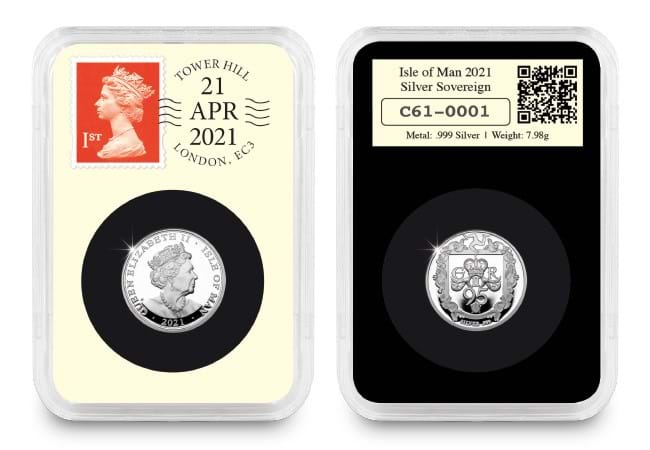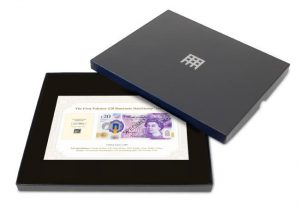Posts Tagged ‘datestamp’
Only 500 collectors can own this WORLD FIRST
Today marks Her Majesty’s 95th Birthday.
And to mark this incredible Royal milestone the WORLD’S FIRST Silver Sovereign DateStamp™ has just been released.
But ONLY 500 are available WORLDWIDE at the incredible price of JUST £59.99 (+p&p).
And in my latest video I explain why you NEED to add this WORLD FIRST to your collection. But with just 500 available, I don’t expect it to be available for long.
If you’re interested…
Click here to be one of 500 collectors to own this WORLD FIRST >>
The secrets hidden in Britain’s most secure banknote yet
Whether you love them or hate them, it’s fair to say that when the Bank of England issued the very first polymer banknotes, UK currency was revolutionised. As well as refreshing the designs of the notes, these polymer versions were considered a cleaner, safer and stronger alternative.
In 2016 it was the £5 that received the first makeover, and Winston Churchill was selected to feature on the note. Jane Austen soon followed on the £10 note and now, as chosen by the British public, renowned artist JMW Turner graces the new £20 polymer note.
But it’s not only the design that makes this note special. You see, the Bank of England have described this note as the most secure banknote yet. So, I’m of course curious to see what special security features have been worked into the design of our newest banknote…
Britain’s most secure banknote
Before the revolutionary polymer £20 came along, there were over 2 billion £20 paper notes in circulation. The sheer volume of them made the £20 note Britain’s most used, and consequently most forged, banknote.
So it’s understandable that the need to make it difficult to counterfeit was at the forefront of the designer’s mind! The result? A whole host of special features that make it harder to forge and stand out from other notes in circulation.
Let’s take a closer look at some of the security features incorporated into the design:
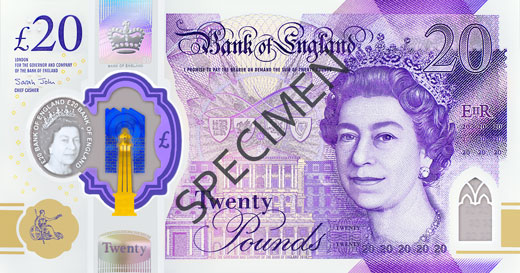
- Transparent windows – the foil in the large see-through window is blue and gold on the front, and silver on the back. Plus, there’s a second, smaller window in the bottom corner.
- Changing holograms – the hologram beneath the large clear pane will alternate between reading ‘Twenty’ and ‘Pounds’ depending on what way you tilt the note.
- The Queen’s portrait in the transparent window – the Queen’s portrait is printed on the window with ‘£20 Bank of England’ printed twice around the edge.
- Foil patches – a silver foil patch contains a 3D image of the coronation crown. There is a second purple foil patch which contains the letter ‘T’.
- Ultra-violet technology – under UV light, the number ’20’ appears in bright red and green on the front of the note, against a duller background.
- Raised dots – you’ll find three clusters of raised dots in the top left hand corner. This tactile feature helps blind and partially sighted people identify the value of the note.
JMW Turner design
When choosing the design for the £20 note, the Bank of England were spoilt for choice. They received over 29,000 nominations submitted by the general public. And the choice to select JMW Turner makes him the first British artist to ever feature on a UK banknote.
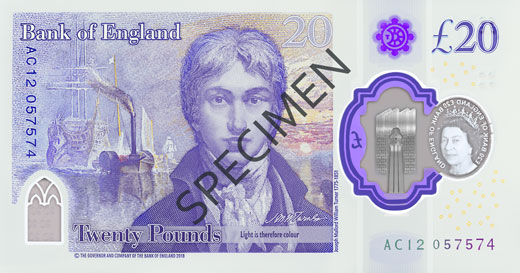
The note itself features Turner’s 1799 self-portrait, which is currently housed in the Tate Modern in London. And behind this you’ll notice one of his most recognisable works – The Fighting Temeraire. This famous painting is a tribute to the ship that played a pivotal role in in Nelson’s victory at the Battle of Trafalgar in 1805.
The final nod to Turner in the design comes from the quote “light is therefore colour”, alongside the signature taken from his will. The quote is taken from a lecture Turner gave in 1818 and is a reference to his innovative use of light, shade, colour and tone.
What do you think about the new £20 Polymer note? Let us know in the comments!
If you’re interested…
If you’re looking for a way to own this significant, revolutionary piece of British currency, then look no further than the UK 2020 £20 Polymer Banknote DateStamp™ issue. Each DateStamp™ issue has been postmarked by Royal Mail with the note’s first day of release – 20th February 2020 – forever ensuring its provenance.
First issues are always valued by collectors and by owning the DateStamp™ issue you will be one of just 2,500 collectors able to forever mark the date the new £20 polymer banknote entered circulation. We have a limited number available, so click here to find out more >>
The Making of a British Icon
How an Italian engraver produced the most British coin of all time
Across the world, one coin is seen to epitomise all that it is British in a way that compares with nothing else. That coin is the Gold Sovereign. And at the centre of its international reputation is a quintessentially British design – St. George slaying the dragon.
Yet it is not, as you may first think, the work of a classical British artist, but instead that of the second son of an Italian federal court judge, who only came to England just two years before his portrayal of St. George and the Dragon first adorned a British coin in 1817.
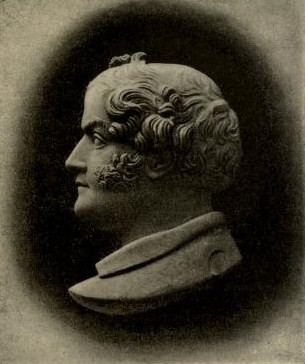
Cameo of Benedetto Pistrucci, by his daughter c. 1850
In fact well before his arrival in England in 1815, Pistrucci was already well established as a leading gem engraver and producer of fine cameos amongst European high society. He rapidly made an impression on his arrival in London, winning the approval of the well-known antiquarian William Richard Hamilton.
Despite having no coin or medal experience, he was quickly commissioned by the Master of the Mint Wellesley Pole, brother of the Duke of Wellington, to produce a new portrait of George III as part of the Great Recoinage. His model, created in the unusual medium of red jasper, was re-engraved by Thomas Wyon for its final use on coinage losing, in Pistrucci’s eyes at least, much of the detail.
However, his work was clearly of sufficient quality to impress Pole, who followed up with a commission for the design that has forever since been the synonymous with the name Benedetto Pistrucci – St. George and the Dragon.
A design nearly lost the annals of history
Yet within just eight years it looked like Pistrucci’s design might disappear forever, as the Royal Mint changed the Sovereign reverse design to an heraldic shield, which was to remain in place for the next 46 years.
It was only a drive to improve the design quality of the coinage, led by new Deputy Master, Charles Fremantle that saw the re-introduction of St. George in 1871. However, both reverse designs were struck concurrently until 1887 when the Chancellor of the Exchequer declared that “by tradition and recommended by the great beauty of the design” Pistrucci’s design should once again appear on all Gold Sovereigns.
“The chief coin of the world”
By the mid-1850s the “new” Gold Sovereign had become a coin of true international status. Indeed an official list identifies no fewer than thirty-six colonies and dependencies in which the gold sovereign or half sovereign was recognised as legal tender.
More surprisingly, so great had become the reputation of the British sovereign that it was also in regular use in other countries outside the Empire, including Brazil, Egypt and Portugal.
However, it was the opening of the Sydney branch of the Royal Mint in 1855 following the discovery of gold in Australia that really marked the international growth of the Sovereign. Initially authorised to strike Sovereign’s to a different design, in 1871 Sydney finally started to strike coins of the same designs as the UK (just in time for the Pistrucci revival), only identified by a small “S” mintmark.
Further Australian Royal Mint branches followed in Melbourne in 1871 and Perth in 1899, before the Mint’s reach extended to other Empire countries with branches opening in Ottowa (1899), Bombay (1918) and Pretoria (1923) – all producing Gold Sovereigns.
It is no wonder that the eminent economist of the early 20th Century, Sir John Clapham, proclaimed the Gold sovereign as “the chief coin of the world”.
A worldwide modern icon – good enough for 007
The last international sovereign was struck in Pretoria in 1932. By then the international interest in Gold Sovereign, which started in Victorian times was well and truly established. And it is a reputation that continues right up to today.
Ian Fleming chose to equip James Bond with 50 Gold Sovereigns in his attaché case in the From Russia with Love, whilst Special Forces are still believed to carry Gold Sovereigns, as an emergency international currency.
In 2012 the Royal Mint once again authorised the striking of the St. George and the Dragon Gold Sovereign outside the UK under licence in India, so great is its popularity amongst the people there.
Reference
“The Royal Sovereign 1489 – 1989”, Ed GP Dyer
“A New History of the Royal Mint”, Christopher Edgar Challis
The Royal Mint Museum Website
________________________________________________________________
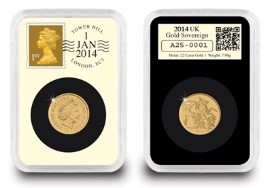
The 2014 Gold Sovereign is available in a limited edition DateStamp™ Presentation of just 995 pieces –now sold out.

